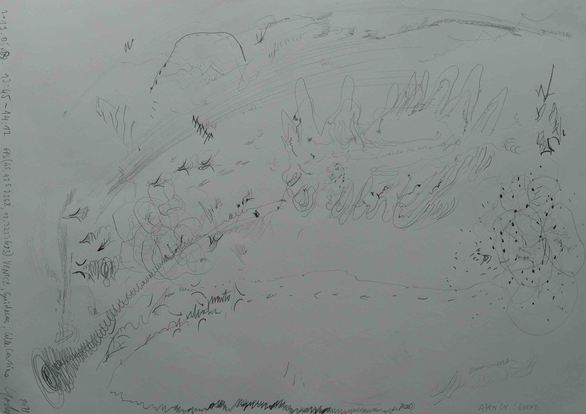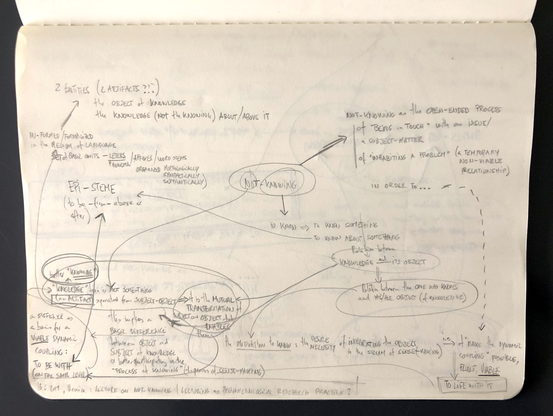The Reading Circle is a practice of collective reading and commenting texts, or better, is a practice of collective thinking through reading and commenting texts. This practice was developed during two preparatory meetings at the University of the Arts Helsinki. In these meetings, a group of participants in the research cell Through Phenomena Themselves addressed different aspects of phenomenology to prepare their work in Venice.
The Reading Circle practice consist in few rules:
1. Someone in the group begins to read aloud the selected text and continues reading it as long as she decides. When she stops reading some else continue, and so on.
2. While someone is reading everyone else or even the reader herself can interrupt by saying “stop” in order to comment or ask questions. This can be the beginning of a conversation.
3. Everyone can interrupt the conversation or even prevent it to begin by saying “continue”. The reading will be resumed immediately.
4. While reading everyone can ask the reader to read slower (by saying “slower”), lauder (by saying “lauder”) or to repeat a sentence or a paragraph (by saying “repeat”).
This set of rules can be modified by practicing.
This was the selected bibliography for the preparatory meetings and the practice sessions at the Research Pavilion:
Bernet, Rudolf. “Phenomenological and Aesthetic Epoché: Painting the Invisible Things themselves”. In Dan Zahavi (ed.): The Oxford Handbook of Contemporary Phenomenology. Oxford: Oxford University Press. 2012. 564-582.
Cerboner, David R.. “Phenomenological Method: Reflection, Introspection, and Skepticism”. In Dan Zahavi (ed.): The Oxford Handbook of Contemporary Phenomenology. Oxford: Oxford University Press. 2012. 7-24.
Gallagher, Shaun and Zahavi, Dan (2008). The Phenomenological Mind. An Introduction to Philosophy of Mind and Cognitive Science. London: Routledge. 13-43.
Jacobs, Hanne. “Husserl, Heidegger and Merleau-Ponty on the World of Experience”. In Dan Zahavi (ed.): The Oxford Handbook of the History of Phenomenology. Oxford: Oxford University Press. 2018. 650-675.
Merleau-Ponty, Maurice (2012). Phenomenology of Perception. Abingdon: Routledge. Lxxi - Lxxxv.
Mertens, Karl. “Phenomenological Methodology”. In Dan Zahavi (ed.): The Oxford Handbook of the History of Phenomenology. Oxford: Oxford University Press. 2018. 469-491.
Moran, Dermot (2000). Introduction to phenomenology. Abingdon: Routledge. 124-163.
Moran, Dermot: “Intentionality, Lived Experience, Bodily Comportment, and the Horizon of the World”. In Dan Zahavi (ed.): The Oxford Handbook of the History of Phenomenology. Oxford: Oxford University Press. 2018. 579-603.
Smith, Joel (2016). Experiencing Phenomenology. An Introduction. Abingdon: Routledge. 1-9 and 30-49.
van Manen, Max (2014). Phneomenology of Practice. Abingdon: Routledge. 15-71 and 215-391.
Zahavi, Dan (2003). Husserl’s Phenomenology. Stanford, CA: Stanford University Press. 7-159.
In May my work in the framework of Through Phenomena Themselves was focussed on my collaboration with Nikolaus Gansterer in the context of the artistic research project
In June, I concentrated in the performance of three language-based practices:
Exploratory aesthetic essay writing is a a practice of very slow observation of a concept or a state of affairs by activating the medium of written text through aesthteic conduct (for a first outline of this notion, see: Embodied and Situated Aesthetics; An enactive approach to a cognitive notion of aesthetics). The morphology, syntax, semantics and distribution on a surface of the written signs—i.e. the enabling conditions that this medium provides for the performance of the practice—in interaction with the physical position and the actions of operating with the technologies of writing in an open-ended, desinterested, receptive and sensorimotor attitude of awareness—i.e. the enabling conditions that the writer provides—allow for an unpredictable disclosure of the essay's object.
At the Research Pavilion I did not write any new essay. In the context of CONVOCATION – on Expanded Language-based Practices I read publically the essay Aesthetic Research, which will be publish in the upcomming book Architectures of Embodiment (Diaphanes). By clicking on the grey box underneath, you can download the exploratory essay Disclosing an architectural object. Settlement 14, which I read
publicly in the context of PERFORMATIK 19 at KANAL - Centre Pompidou (Brussels).
Contingent Agencies is a framework to inquire into the agencies of the different entities that enable the emergence of specific atmosphere or environment, i.e. significant but non-objectified, precise but vague, ephemeral and enveloping presence.
Contingent Agencies is a four year artistic research project (2019-2022) funded by the Program for Arts-based Research (PEEK) of the Austrian Science Fund (FWF).
I consider all these practices to be aesthetic practices of very slow observation: systematized forms of action that aim at disclosing the intended object of research through an intensified awarenes enabled by a spontaneous, sensorimotor and emotional relationship between the practitioner and her environment.
Following the remark that Juha Himanka made in one preparotory session about a situation in which Husserl was thinking phenomenology in the very process of given a lecture, Juha and I decided to set up an experimental procedure in order to explore the possibility of considering lecturing as a phenomenological research practice, i.e. not as a practice of talking about phenomenology but of doing phenomenology.
We decided to give three lectures at the Research Pavilion in three consecutive days: one lecture by each of us separately (we decided to set the order of this lecture by chance few days in advance) and one closing lecture together. We decided that the subject matter of the lectures was going to be "not-knowing". We decided that each of us was free to use any kind of media, and to design, frame and perfrom the lectures freely. Finally we decided to not talk about it anymore until we meet at the Pavilion to give the lectures.
A coin thrown in the air decided that I was going to give the first lecture. I conceived my lecture as a Framed Dialogue. This is a practice I have been developing in the last years. On a first step, it consists in the realization of a diagram (sometimes in different working sessions throughout a long period of time) as a medium to think the subject matter I am addressing. On a second step, I enter in dialogue with the audience (better: my dialogue/research partners) by navigating the diagram. In other words: the subject matter is thought collectively using my navigation of the diagram as a framework in and with which the dialogue takes place.
Alex Arteaga’s research integrates aesthetic and phenomenological practices relating to aesthetics, shared agencies and the emergence of sense and environments. He studied composition, music theory, piano, electroacoustic music, and architecture in Barcelona and Berlin and received a PhD in philosophy from the Humboldt University. Currently he is key researcher in the artistic research project Contingent Agencies (hosted by the University of Applied Arts Vienna and funded by the Program for Arts-based Research of the Austria Science Fund), is professor for artistic research and co-coordinator at the Research Master in Art and Design (EINA / Universitat Autonoma de Barcelona) and lectures in the MA Sound Studies and Sonic Arts (Berlin University of the Arts).
Research Project Contingent Agencies
Research Project Architecture of Embodiment



